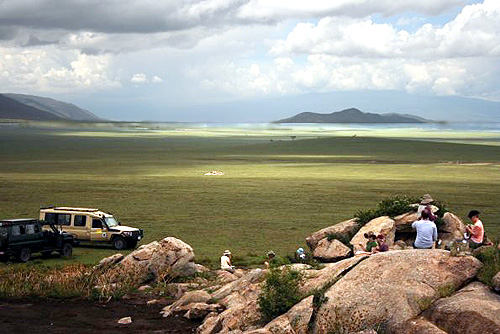
Jim is out of cell phone or internet ranges. Come back next Monday when his actual adventures will replace this post holder.

Jim is out of cell phone or internet ranges. Come back next Monday when his actual adventures will replace this post holder.
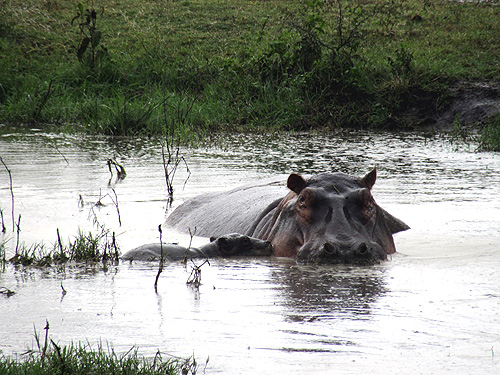 Hyaena, hippo and the remarkable northern wheatear framed below the brilliant stormy skies of the crater were our special attractions, today.
Hyaena, hippo and the remarkable northern wheatear framed below the brilliant stormy skies of the crater were our special attractions, today.
Ngorongoro Crater has got to be one of the handful of most amazing places anyone can visit. Once the highest structure on earth, this super volcano blew its stack geologically quickly, causing untold devastation and leaving for us today one of the most awesome and beautiful structures on our planet.
The crater rim is 1600-1800 feet above a 100 sq. mile caldera that is a wildlife and scenic paradise. Totally wild, this crucible of wilderness changes radically with the least change in weather and so is a precious barometer of what climate change means.
Forced into smaller and smaller ponds because of the exceptional dryness of this year, we found a pod of hippo mothers with young! Now to understand how unusual this is, note that the normal behavior of a female hippo that has just given birth is to sequester herself and her offspring far away from other hippos.
Normally this means several weeks to a month alone and out of sight. The weather in northern Tanzania has been seriously dry, though, and particularly in the crater hippo ponds are substantially shrunk.
So we saw a collection of around 20 adult hippos and at least 5 very small babies (all under a month), crowded together and seeming to do very well. Was this a nursery herd, so to speak?
Hyaena have a heyday when the veld is stressed. Many predators do, but the hyaena especially since it eats almost anything it steps on.
We must have seen at least 100 hyaena. They were eating ankle bones, dead meat, harassing buffalo (!) and even daring to come into our picnic area! Clearly they were juiced up, and every one of them was fat.
The giant lion pride we saw was also fat, so that meant no action. The 20 in the pride on the table mountain on the west side of the crater were totally sacked out. Only the cubs gave us any action.

My personal highlight was seeing the bird in the crater that I regularly see in Alaska in June! The northern wheatear undertakes one of the most unbelievable migrations of any creature on earth: nearly 10,000 miles one-way (of course twice annually).
For the last several years the climate in East Africa (as throughout the whole world, I suppose) has been unusual.
Currently throughout most of northern Tanzania and southern Kenya it’s seriously dry. In the last several days we may actually have seen the dry spell breaking. We witnessed magnificent storms as we left Tarangire and throughout the day in Manyara, and game viewing today in the crater was a dosey doe with very heavy rains.
But if this is the end of the dry spell, the past effects will obviously linger for a while. I reckon less than half the usual numbers of animals were waiting for us today in the crater. Those that were there, several thousand wildebeest and twice or more than of zebra, had very young babies and were probably very late births, constricting them from moving.
None of the animals appeared sick or weak, as would be the case in a real drought. I’m sure we’ll learn more as we head now into the Serengeti for our last five days.
Stay tuned!
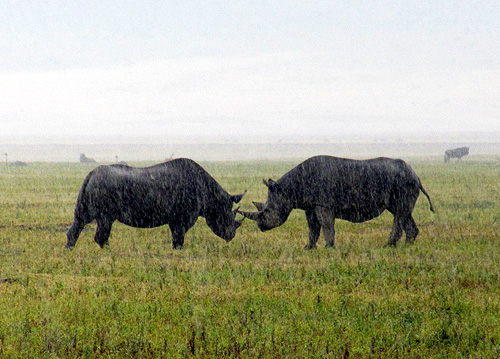
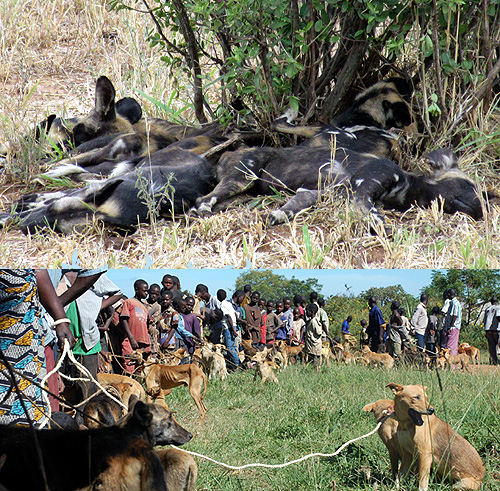 First game drive Tarangire: 7 lions, leopard, maybe 300 (?) elephant, tons of impala, waterbuck … oh, before I forget, 17 wild dog.
First game drive Tarangire: 7 lions, leopard, maybe 300 (?) elephant, tons of impala, waterbuck … oh, before I forget, 17 wild dog.
The top half of the picture above shows a portion of that family zonked out towards the end of the day. They’d killed that morning and were basically sleeping it off.
Several weeks ago Steve Taylor leading an earlier EWT safari spotted wild dog in the Serengeti!
I think this marks the turnaround point for wild dog, and the successful work that several American zoos have been doing to stabilize their populations.
Zoos like Chicago’s Lincoln Park Zoo have painstakingly convinced Maasai who live on the periphery of the park to get their dogs vaccinated … free. It’s no easy job. (See bottom half of picture above.)
But the hard work has paid off. By vaccinating the peripheral dogs, wild dogs are staging a bounce back more resilient than expected.
Our safari stayed in the center of Tanzania, which I do with some trepidation this late in March because of the rains. But this year it’s been unusually dry. It’s not yet a crisis, but the veld looks like October more than March.
The Silale Swamp was only half green. We experienced sprinkles and I kept looking at the sky’s growing clouds wondering if the much needed rains would return.
It was also unusually hot. Humid, hot and extended dry conditions means more tse-tse and it was really among my worst experiences. But my travelers were incredible, never complaining, spraying on the DEET and getting on with the business of game viewing.
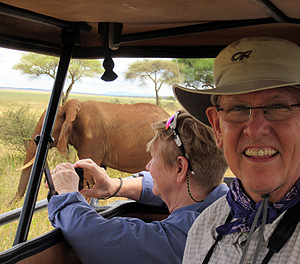
We’d flown into the Kuro airstrip so we were in the midst of the park. The leopard was in perfect view on a dead tree looking with aggravation at a nearby herd of impala. I say aggravation because he, too, had a giant belly and had no need to hunt.
Perhaps the impala knew!
We had a single encounter with truly wild elephant that are mostly transitory south of the Kuro airstrip. It was hilarious. We rather surprised a single family, and one female who was nibbling on a smaller acacia tree was so startled that she ripped the entire tree out of the ground and ran off!
The hundreds if not thousands of elephant we saw were mostly the sedentary group north of Kuro. They tend not to move in and out of the park, content with the space and habitat. More docile than very wild elephant, it allowed us numerous wonderful encounters.
I think everyone was particularly pleased as we watched three very young elephant rough house for nearly 15 minutes.
They “jumped” on one another, rolled each other, butted each other … I put quotes around jump because that’s virtually impossible for an elephant to do, but I really believe I saw that youngster fully airborn if for only a nano second.
I’ve noticed that most of the southern European and western Asian bird migrants haven’t yet left (like the Eurasian Roller and Steppe Eagle [buzzard]), whereas most of the central and northern European migrants have (Adim Stork, Eurasian bee-eater). Don’t know if that means anything – please leave a comment if you think you understand this.
We left Tarangire hurriedly so that we’d have enough time to see Manyara from top to bottom, entering from the remote southern gate. It’s a spectacular drive through rural Tanzanian countryside, including intense small farming of rice and corn.
Manyara, too, was dry but it was wonderful as we left late in the day to see the thunderstorms forming.
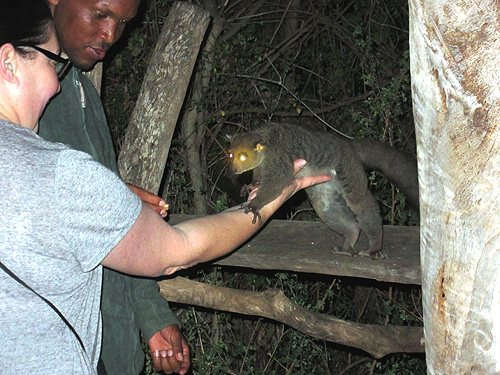
Ndarakwai Ranch is one of many private concessions in the foothills of Mt. Kilimanjaro. Its 11,000 acres of beautiful undisturbed veld where wild animals and Maasai herds have coexisted for years.
We spent the morning walking, after I determined that there were no elephants in the area, and because it was so cloudy.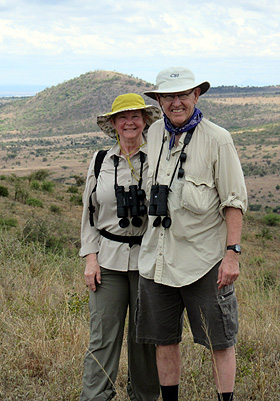
We walked past several dozen giraffe, dozens of zebra and wildebeest, impala, and an amazing number of eland. There was also warthog, Grant’s gazelle and lots of baboon.
From the earliest traditional days with the Maasai herders and continuing uninterrupted today with safari guests the animals are unmolested and have become pretty tame. Most of these animals are spillovers from nearby Amboseli National Park, but their behavior and acceptance of us walking near them suggested they were more sedentary than transitory.
West Kili is pimpled with old ash cones that over the eons have formed into beautiful hills with considerable vegetation. We climbed one, following an animal path, until we were about 400 feet above the slopes on which the ranch was located.
The views were superb, of course. To the west was towering Mt. Meru, over 13,000′ high. To the northwest was the great pan of Amboseli and we watched dust devils twist across it.
To the east, of course, was the granddaddy of them all, Kilimanjaro. Throughout this cloudy day it cleared by for a few minutes, but most of the day quite a lot of the mountain was available with the clouds forming gorgeous wraps around its peak.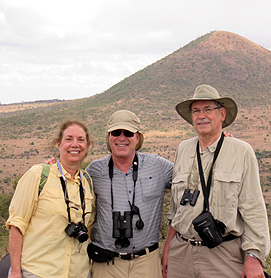
We had good birding, too, including lammergeier, fully feathered breeding steel blue whydah, several types of rollers, waxbills and finches, plus a wonderful array of raptors including augur buzzards, black-crested hawks and tawny eagles.
When we descended the hill I called for our rovers to drive us home and in the afternoon we took a more extensive game drive, seeing a considerable number of wildebeest and zebra. These are not a part of the great migration, although they probably move between Amboseli and possibly Tarangire via Meru.
Our day ended at the ranch’s tree house, which overlooks a beautiful vlei that had zebra, warthog and baboon, and incredible views of the Kilimanjaro landscapes.
“Can we say that we climbed in the Kilimanjaro foothills?” Hope Koncal asked anxiously.
Absolutely, and it was wonderful exercise and a wonderful way to slip into the magic that Africa holds you in.
We took a rather creative way here from Arusha, traveling through Arusha National Park from its southern to northern gate. It was a great game drive itself, with waterbuck, buffalo, giraffe, zebra and impala.
But there were three really great bonuses!
The first was when we saw a red duiker in the deep forest. This animal is growing increasingly endangered because of the erosion of forests. I hadn’t seen it for several years, and I was surprised how literally red it seemed. About the size of a small pig, it moves stealthily and quickly when noticed, so we had but a few minutes to enjoy it.
We also saw the prized colobus monkey that the park is so famous for. These are probably East Africa’s most beautiful monkey, with their long white tails and flowing black-and-white manes.
And we lucked out big time when the Momela Lakes gave us probably 30-35,000 flamingoes! We sometimes see them here, often not at all, but rarely have I seen so many.
And now, on to Tarangire!
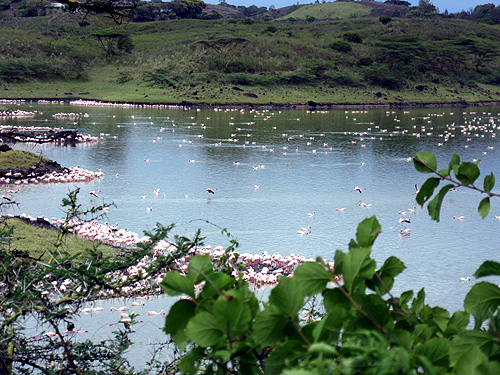
 Elephant hysteria has reached a new high, and I left Botswana amazed at how dangerously unorganized elephant protection is.
Elephant hysteria has reached a new high, and I left Botswana amazed at how dangerously unorganized elephant protection is.
The almighty and by this writer much revered CITES seems wobbling. African research organizations nip at each rather than cooperate to gather much needed facts. Positive moves in China get ignored so the country can be bashed still again. Meaningless grandstanding gets the headlines.
And so, we clone a wooly mammoth?
I’m not kidding. Within four years we’re going to have a live wooly mammoth, with DNA from a permafrosted 3300 year-old baby slipped into the DNA of a healthy modern elephant by Harvard researchers.
Zimbabwe is among the best places to traffic ivory, and now even live elephants. In blatant disregard of CITES, Zimbabwe is sending 34 baby elephants to Asia and Arabia.
The outcry was formidable, but not a single country in CITES asked that the treaty enforcement provisions be applied to Zimbabwe.
It’s a circus, folks. At least for three more years. That’s when Ringling Brothers has announced they will discontinue using elephants. Jump to hashtag #3YrsTooLong.
What you have is a mess. Nobody really knows how much poaching is going on. The reported figures are so disparate as to be laughable.
The once respectable Save The Elephant Fund issued a critical news release claiming that 50,000 elephant were poached annually, while the also once respectable National Geographic said 25,000.
Think one of them’s wrong? Or both?
We have no idea how many elephant are being poached, for the same reason that we have no idea how many elephant there are. African government wildlife agencies don’t undertake counts or can’t be trusted, and not-for-profit wildlife NGOs refuse to cooperate because it might jeopardize their fund raising.
One of the most respected government wildlife agencies, the Kenyan Wildlife Service, sacked five top officials last year for involvement in the ivory trade. Hardly a day after one of Kenya’s most notorious wildlife traffickers was arrested on an Interpol warrant, the man jumped bail.
Meanwhile, the Ethiopian Government – probably among the top conduits for illegal ivory – won headlines worldwide for burning ivory and proclaiming a “Zero Tolerance” for wildlife poaching. But no journalist noticed that the entire top of the pyre was actual carved ivory sculptures and trinkets. Ivory isn’t carved until it gets to Asia. Where did that come from?
You confused? Join the pack.
His Excellency the honorable Minister of Environment, Wildlife and Tourism, Tshekedi Khama, told a conference in Botswana last week that any elephant problem that exists doesn’t come from Botswana elephants, but “ensues from elephants that migrate from neighboring countries,” which – he then deduced for us – means that those countries have serious problems.
We just finished a successful safari in Botswana, and we didn’t see all that many elephants, but I’m told more elephants exist in Botswana than anywhere else on earth.
Do I believe that?
Jim filed this from Arusha, Tanzania.
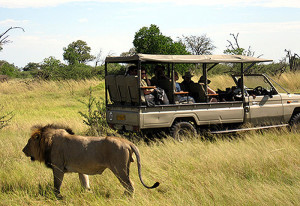 The rains returned! There’s no way of predicting for how long, of course, or if the serious deficit in moisture will be significantly reduced, but the two days of thunderstorms in my opinion was the reason our game viewing ended so well.
The rains returned! There’s no way of predicting for how long, of course, or if the serious deficit in moisture will be significantly reduced, but the two days of thunderstorms in my opinion was the reason our game viewing ended so well.
We ended our Botswana safari with three days in Moremi, our third ecosystem after the Kalahari and the Delta.
Moremi is Botswana richest game viewing area. Much of it spills into the Delta, and it includes the large Chief’s Island in the middle of the Delta. We were near the Xaxanaka gate, pretty much in the middle.
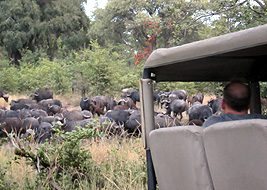
Two game drives daily netted us 9 lion, a leopard on a kill, a giant family of buffalo and about two dozen elephant.
The circuit that brought us to the lion went through thick mopane forests and shorter thick bushlands so typical of central Botswana. This makes game viewing difficult, but when we emerged onto the edges of several ponds we found good game.
Kudu, sassaby, impala, giraffe zebra and wildebeest were also seen on this single game drive. The giraffe here, by the way, seem to be bulkier and have a boxier face than those I know so well in East Africa. Their coloration was radically different from individual to individual, from near powdery white to nearly black.
What was also interesting was that the coloration of the giraffe did not completely follow the rule of thumb that the older males are darker. There were old white males and dark females.
When coming upon one pond, we watched a massive hippo jump out into the adjacent forests, scattering three good-size crocs.
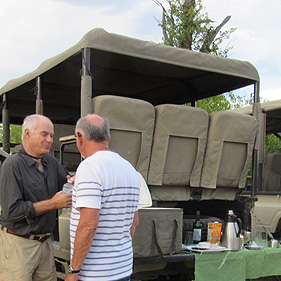
Earlier we saw a marvelous family of buffalo, probably numbering close to 50, with quite a few youngsters and several very young babies. They were on and around a ridge of stunted bushes surrounded by a sea of high oat grass. The afternoon light provided an absolutely beautiful canvas.
It’s been hot. My thermometer registered 103F for each of three days at between 1 and 2 p.m. Everyone would be sleeping, relaxing or swimming then, and by sundowners it had cooled down considerably, especially because (fortunately) the rains seem to be returning. By dinner we were in the upper 80s.
We saw so much damage in Moremi from the radical climate swings of the last few years : from horrible flooding to near droughts. Large stands of old trees had been killed. When the delta raised to unnaturally high levels in heavily forested areas that hadn’t seen water for decades, it created a thick alkaline froth.
On our last evening together there was much celebration of the trip’s success. Many of the non-veterans said the game viewing exceeded their expectations. From my perspective, the game viewing was a bit slow until the last day, when the game drives really delivered.
Also in my opinion, the real prize of the trip was the Pell’s Fishing Owl. I’ve only seen it once before – in the Delta – and not as close as we got this time. Although I didn’t see one, others in the group did get a fleeting glimpse of a sitatunga, the extremely unique water antelope with webbed feet.
So in spite of a serious lack of rain that preceded our arrival, and fires that besieged much of our actual trip, I think it’s fair to say Botswana performed well for us. Of course much in the wild is simple chance but that’s part of the exhilaration!
For some on the trip, now, it’s on to VicFalls. To others, they’re returning home. And for me … to East Africa!
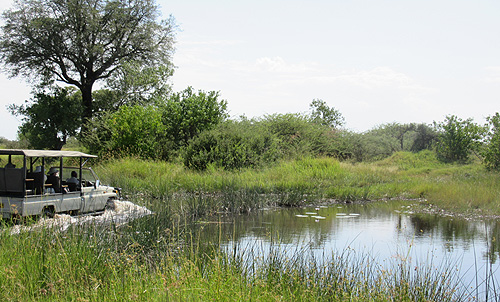
 The one-of-the-kind Okavango Delta in far off Botswana, like every other part of the world, is threatened by climate change caused by factories in China and soccer moms’ SUVs in Minneapolis. It makes our time here now even more treasured.
The one-of-the-kind Okavango Delta in far off Botswana, like every other part of the world, is threatened by climate change caused by factories in China and soccer moms’ SUVs in Minneapolis. It makes our time here now even more treasured.
Numerous studies as early as 2007, from a variety of high-tech government organizations around the world, have established that the Okavango is in for a mighty wallop
I experienced it myself two years ago when the flow from Angola was so severe we were flooded out of our first camp.
Last year was “unusually normal.”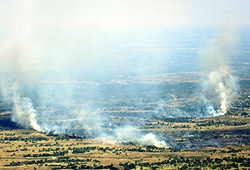
This year is a near-drought. With about a quarter of the normal rainfall and record high temperatures, about a quarter of the Delta has been lost to fire.
When natural and moderate, fire is a good and necessary part of any wilderness, but this year was excessive. Fewer birds, fewer animals, more hoof and mouth disease, and many dislocated animals are the result of this massive inferno.In our camp in Xugana a poor vervet monkey leaped from tree to tree screaming. There had never been vervets on Xugana Island. He was running from the smoke and flames.
Few places in the wild world are studied as intensely as The Delta. This is because it’s so unique. No one is happy with what is happening or what is expected to come soon. If all this fire is followed by flood, it will be terrible for the natural regeneration of plants. Too much water alone will significantly change the Delta.

But what does this mean for animals and plants, for the system as a whole? I’ve often written that the ecology of Africa is marvelously adaptable. The problem is what will that adaptation be? Retreat from man? A part of the downwards spiral of increased carbon emissions?
For my clients the last two days have been magnificent.
With sufficient time to experience multiple Botswana ecosystems, we were able to dedicate two entire days to an exclusively water-based camp, located on Xugana Island.
At the edge of the Delta from Camp Moremi we saw the rarest owl in the world! The Pell’s Fishing Owl, the only owl that fishes. It was a beautiful, large, red sand colored bird. We saw hippo, of course, and hippo with newborns. 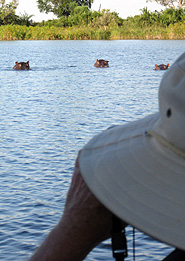
On a walk on nearby Sausage Island, clients saw red lechwe, elephant, water buck and impala. Several of us fished, successfully, for the tasty red-breasted bream.
And everyone enjoyed the spectacular sunsets and sunrises, the unique colors of the fall papyrus and late blooming water lilies picking out the deep resonance of the afternoon sun.
And we all watched the fires. From the air when we flew from camp to camp, and even from our camps. At night when the breeze stilled, the smell of smoke was everywhere. Ash was on our table cloths.
This time it was truly magnificent.
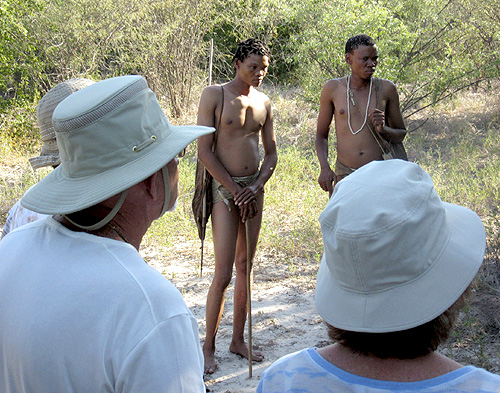 The Naru Bushman experience was the highlight of our two days in the Kalahari.
The Naru Bushman experience was the highlight of our two days in the Kalahari.
I’m continually upset when clients ask me to “visit a village.” There are no traditional villages left in most of Africa, and certainly not in the areas that tourists can visit. 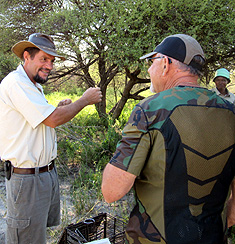
What their friends saw and what they ask me to see are horrible remnants of traditional life. As Africa progresses rapidly, traditional life styles are understandably being lost as Africans seek better education and a better life.
In many countries in sub-Saharan Africa, however, the development cannot meet the demand, and so many traditional peoples get caught between the old ways and the new ways.
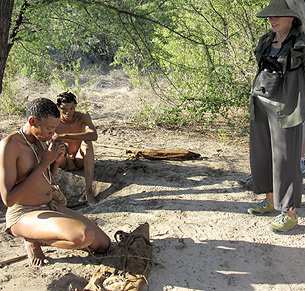
The so-called “villages” that people claim to have experienced are impoverished groups of people who wish they were better off and in most cases are stuck in the worst of two worlds.
It is the identical situation to many impoverished communities in America — distressed villages in Appalachia or southwest Wisconsin. I’m infuriated that travelers will actually return from these visits, claiming to have experienced “the real Africa.”
No longer nomadic, many of these so-called villages become unclean and their children get sick. That was not the case when nomadic peoples moved regularly. Unable to get the jobs that their schooling prepared them for, they down poorly maintained traditional garb for tourists and “interpret” the old ways in the near perfect English they would prefer was being used in a business in town.

In the end traditional life is not conveyed at all. What is conveyed is the disgusting failures of modern development. The glorious and successes of traditional Africa life ways are completely obscured.
Braame Badenhorst, owner/manager of Deception Valley Lodge, has mastered a display of early Bushmen life without denigrating the people who portray it.
Our two Naru Bushmen trackers, both 31-year olds and fine staff additions to our successful game drives, traveled with us into the bush, then hopped off the vehicle as our other guide, Jacob, explained they were going to change costumes.
Bramme wants people to understand what real traditional Bushmen life was like, especially the younger generation of Naru. But he makes no bones about it: “There aren’t any traditional Bushmen, anymore,” he flatly tells his guests.
What his two staff members are going to do, to both our and their benefit, is reenact what it was like 30 years ago.

So they stripped off their khakis, pulled out their earplugs from their iPhones, and gave us the best example of “traditional peoples” I’ve ever had the privilege to see.
It was fabulous. The kids, who I’m ashamed to say I can’t transliterate their names, had mastered their grandparents’ techniques in water and food gathering, hunting, and tool building. They conveyed to us a life style that may no longer exist, but demonstrated how creative and clever their ancestors’ – our species – can be.
In so doing, they preserved for themselves, us and generations to come, mechanisms and solutions for survival that may be valuable even in the modern age, and will preserve in ways no written account can, the history of these magnificent people.
This was a true visit into the past: an unpretentious reenactment of something that no longer exists and risks being lost forever. 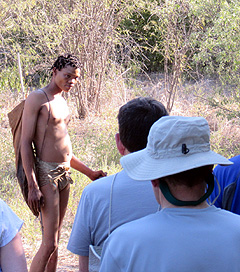
Whether it is innate racism or a weak intellect, travelers are plagued by a desire to see “bad.”
Put a Naru Bushman’s day opposite one of John Boehner’s, and there’s no contest. That’s the truthful message waiting for travelers with a real desire to understand what traditional Africa is all about.
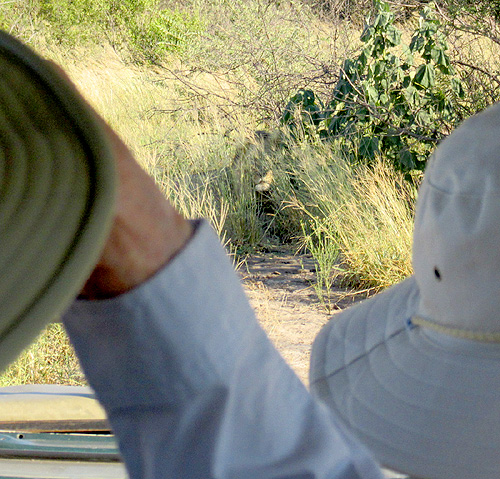 We found a Kalahari lion our first day on safari!
We found a Kalahari lion our first day on safari!
Unlike the more traditional lions roaming the great savannahs of Africa, the Kalahari lion has a lot more work cut out for him. Lions have to flood themselves with water after gorging on a kill or their insides close down.
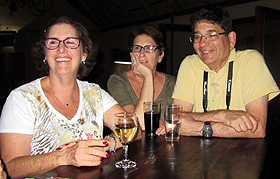
In the best of years, which last year was with regards to rain, the Kalahari gets a few months of tumultuous thunderstorms then dries up. In the long dry part of the year Kalahari lions are restricted to water from the bodily fluids of their kills.
This normally results in a much shorter life span and many fewer lions. The owner/guide of the camp where we’re staying, Deception Valley Lodge, told us that traditionally a Kalahari male lion’s territory could extend into the hundreds of square kilometers.
It’s one of the reasons that throughout so much of southern Africa, national parks and private reserves have constructed borehills (water wells) for the animals, particularly the larger ones and the carnivores.
Deception Valley Lodge drilled its first bore hole in 1997. The reserve has since continually had a healthy pride of lion that today is dominated by a single male, and three females with nearly a dozen cubs among them.
The male acted like the males I’ve seen throughout East Africa and had a beautiful extensive black mane, but as our guide pointed out, fewer scars because he’s had fewer scraps with other lions … since there are so few lions.
He’s now nearly ten years old, extraordinary for a Kalahari lion. When I watched him walk it was apparent he had hip or spinal problems, but otherwise looked quite regal.
This northwestern section of the Kalahari is thick scrubland with many more low lying trees including a variety of acacias. In several regards it reminds me of the drier parts of East Africa.
During our two days we saw a great variety of animals, including lots of kudu, giraffe, warthog, zebra, lots of steinbok, and good birds including the spectacular crimson-breasted shrike.
On to the Delta!
It rains only briefly, although sometimes torrentially (as last year) so the pools of water necessary for lions are frequent during the rains.
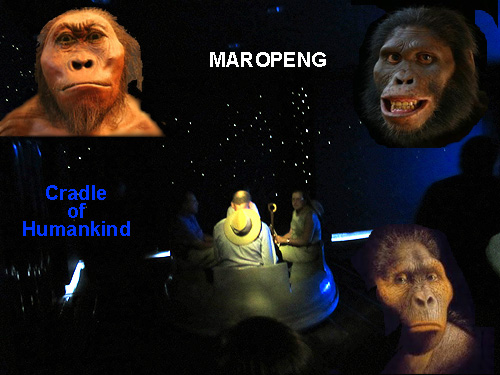 On our last day in South Africa we toured mankind’s first.
On our last day in South Africa we toured mankind’s first.
Or some of his first, anyway.
The Lanzerac was kind enough to give us an early breakfast so that we could leave at 7 a.m. It’s always such a crapshoot in South Africa when traveling around the cities during the week, because of traffic. Their highways are modern, but far too small for the concentrated traffic of rush hour.
We were fortunate. Sometimes from Stellenbosch it can take 90 minutes. We made it in 45, checked in to Mango Airlines and were on our way to Lanseira, the smaller municipal airport on the far northwestern side of Joburg.
That meant we were only 30 minutes from Maropeng, translated: Origins. This World Heritage Site includes the Maropeng center and early man museum, and ten minutes away by car, the Sterkfontein caves.
It shot to prominence 15 years ago when the American, Ron Clark, found “Little Foot,” only the third nearly complete skeleton of an early man, in this case, an Australopithecus Africanus.
So the South Africans sprang for something akin to a mini theme park.
After a brief introduction and circular time line that you walk through, depicting the stages of Planet Earth’s long trajectory to life, there is a short video about the early geological forces that formed the planet.
Then it’s to the “boat ride,” a simulation through time that somewhat parallels the deep river caves in which so many precious early fossils have been found in the region.
And this emerges into a decent museum about early man, and contemporary man.
The several-hour visit cave some meaning to what would otherwise have been just a travel day, something when combining South Africa with Botswana is unavoidable.
And so we end our last day in South Africa back at the lovely Michelangelo in Sandton. Tomorrow, to Botswana!
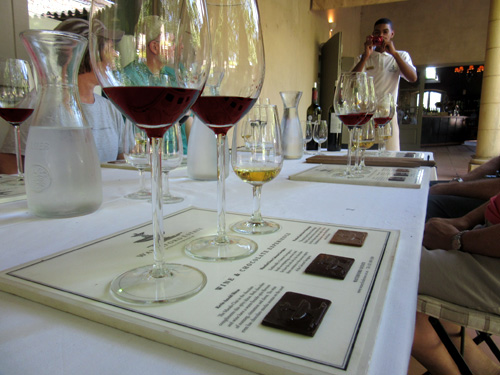 After a day at Cape Point we ended our Cape experience in the wine country near Stellenbosch.
After a day at Cape Point we ended our Cape experience in the wine country near Stellenbosch.
Dogged by unprecedented fires, our touring was only slightly interrupted as part of Table Mountain Park at Cape Point was closed. But the Cape of Good Hope, the Flying Dutchman to the Cape Point and our choice picnic spot at Buffelsfontein were unaffected.
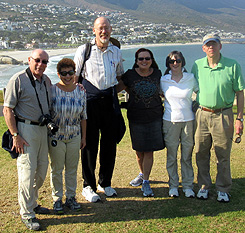
Yet the damage was visible everywhere, from the sometimes heavy haze of distant hillsides still smouldering to the distinctive smell of ash.
An entire mountainside at Hout Bay was scorched.
I love our specially prepared South African picnics, which overflow with enormous varieties of foods and sweets, and I don’t think I’m exaggerating when I say most of my clients think the South African brownie is better!
The African penguin was toddling around in full force at Boulders, on our way from the Cape into wine country. Considered pests by many of the local residents, SANI Parks has created a marvelous sanctuary for them virtually in Simon’s Town, taking the pressure off many private residences.

There is so much more to the wine country than wine. We began the day at Eagle Encounters, a private rescue and rehabilitation center principally for birds, but Alan also discovered some things they take care of that don’t fly!
We’re staying for two nights at the Lanzerac, one of my favorite wine estates for accommodation. The grand rooms are furnished with Boer-style furniture, including some priceless antiques.
Lanzerac wines are excellent, and everyone enjoyed tastings and a cellar tour. We also visited the Tokara vineyard, currently famous for its brash blend of Spanish and traditional French grapes. The day ended perfectly with a chocolate and wine paring at the Waterford estate.
The heart is Stellenbosch, the heart of Boer culture and history. We toured the Stellenbosch museum and its four beautifully restored old homes. There was time to browse the city’s many shops.
Now, one day in Joburg before our venture into Botswana!

Around 60,000 people were relocated out of District Six under apartheid’s gruesome Group Areas Act, from 1966 – 1974. One of those persons was our guide, Linda Fortune, author and advocate for the District Six Museum.
Altogether more than 3½ million people were forcibly removed from their homes throughout the country during that period, but what makes District Six so important historically is that it was probably the most multi-cultural, multi-ethnic area in the country.
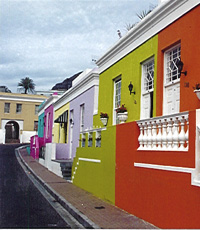
Begun by the Batavian slaves brought to the colony in the 17th Century, District Six had grown into an “old part” of Cape Town with a rich, rainbow heritage. In an area hardly more than 2 sq. miles, virtually every religion on earth had a house of worship, and virtually all of the 11 race classes proscribed by apartheid had been living an integrated life for generations.
So the breakup of District Six is one of the best examples of apartheid’s sinister mechanisms.
Linda’s story, like all the varied guides I’ve enjoyed having from the museum, was an incredibly melancholy one. Today the residents have reclaimed their land, but it will be a long time before the promised reconstruction of what had been bulldozed down will be completed by the government.
Today the district which has just begun rebuilding is vibrant and … colorful. BoKaap merges with District Six and the primary color architecture of BoKaap brings a smile to every face!
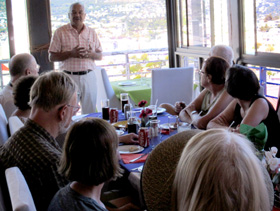
And smiles galore to our tummies, too! We had a special Cape Malay meal prepared by Joey and Nazli of BoKaap Kumbuis. Joey gave us a history of Cape cuisine, which he calls a cuisine franca.
Curry lamb, dall, rice, wonderfully spiced chicken, yellow tail, and of course, Bobotie were just part of the fare.
We also had time to visit Streetwires! This is one of my favorite artisan coops in Cape Town, where 55 young artists are trained to create the most imaginative objects from near full-size Volkswagon beatles to every animal on the African veld … all from wire and beads!
Tomorrow we head to Cape Point. Fortunately the fires are out, the park is completely open and even today the spectacular Chapman’s Peak opened as well!
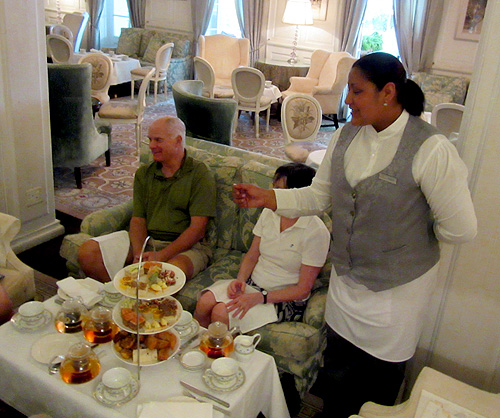
An increasing number of black Americans are traveling to South Africa specifically to visit Joburg and its surroundings. But many white Americans continue to see Joburg as unsafe. They’re very wrong.
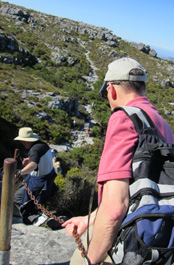
Joburg definitely earned a bum rap shortly after the end of apartheid as local officials really neglected the city. This was compounded by an incredible influx of African immigrants from around the continent, who with the end of apartheid saw enormous opportunities in black Africa’s most prosperous country.
Crime surged, although by the numbers it never exceeded several American cities in all sorts of important categories like burglaries and homicides. But the point was that Joburg had been a very safe and peaceful city, because the police had been so brutal under apartheid.
When the cap was snapped off, compounded by a new republic’s struggle to allocate precious resources and a huge influx of African immigrants, Joburg sank into a veritable mess.
It’s emerged. Our outstanding local guide, Peter Mashaba, took us Saturday into the center of the city. It’s bustling and active although I would be remiss if I didn’t confirm that it isn’t as sparkling and inviting as when I had a shared office in downtown Joburg for several years in the 90s.
But it’s much better than it was only a decade ago, and it’s infinitely better than the perception that many of my clients have.
Our touring took us to Mandela’s posh home in Joburg where the faithful have stacked small stones with inscriptions on two cairns just outside his wall. We also drove by the international headquarters of Anglo-American which has been relocated into the center of the city.
Other large corporations are following suit, including SAB Miller and Rennies. We saw in the deep center of the city where two new hotels were being built.
Although my tour scheduled three nights in Cape Town most of my guests this time have booked five, and I’m filling every moment.
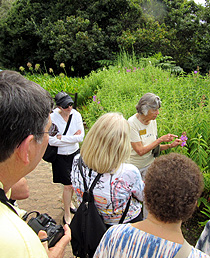
Sunday was with one of my favorite guides in the world, the lovely Dot Malan, who I think knows more about Kirstenbosch Gardens than any person alive. We got an intense tour of several important parts of the gardens.
Today we went up Table Mountain. It was a spectacularly beautiful day and about a third of the group undertook the whole hiking route at the top! In the afternoon I took them on my historic walk through the Company’s Garden stopping to visit an outstanding exhibit by South African artist Penny Siopsis and for a short time touring Slave Lodge.
I have some avid shoppers in this group. They warned me! But the time in gardens and museums they felt so valuable, they canceled the Green Market Square flea market!
Finally, several of us ended a fantastic day – where else? – but at afternoon tea at the iconic Mt. Nelson Hotel.
Any big city can provide attractions to easily fill a week of touring, and I always feel that we’ve never done enough. I worry, too, that I might be pushing my folks too hard. But so far, anyway, the feedback from this group is … fabulous! What’s next?
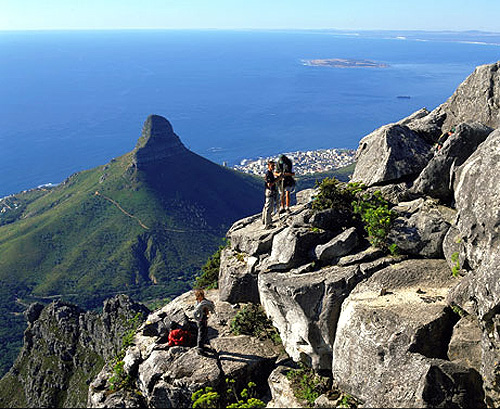
 In less than a week I take my group to the Cradle of Humankind, and it’s appropriate that yesterday a milestone discovery was announced.
In less than a week I take my group to the Cradle of Humankind, and it’s appropriate that yesterday a milestone discovery was announced.
In what has certainly become the paradise for human fossil hunters, Afar in Ethiopia, a Univ. Of Arizona grad student found a mandible with teeth of a creature most scientists’ first looks suggest was our oldest direct ancestor.
This homo habilis is dated to 2.8 million years old, 400,000 years older than the next oldest find so far of this species.
While it will be a while before a scientific consensus can be achieved, the way I’m reading the first reports generated from the Nature publication, I think there’s a lot of loud clapping and back slapping.
There had been a gap of about a million years between rich and varied early man fossils of 3 million years and older, and 2 million years and younger.
The older ones are universally considered pre-hominid and most have been classified as Australopithecus. The younger ones begin with homo habilis and branched into at least one other species, homo erectus, before us – homo sapiens. This is the simple view, anyway. A good number of scientists would divide the fossil record into seven or eight additional species.
But in all cases, whether there were only two early man species, or eight, homo habilis was the oldest, so the first. This find that extends habilis into the million-year gap of which so little is known gives tenure to the notion it really was the first homo.
The problem is simply with having found so few species in this epoch of time. The reason for having found so few of them might have been relatively dramatic climate change. In a time of rapid climate change the chances of anything becoming fossilized are greatly reduced.
Not coincidentally, some scientists are now considering the possibility of rapid climate change in this period as the actual reason for the speciation of homo. Homo survived, Australopithecus and who knows what else, didn’t.
I find it somewhat confusing that a number of scientists are using this find to suggest that homo habilis evolved from Australopithecus. Seems to me that’s a stretch, and that it may be just as likely that Australopithecus and habilis both evolved from something else, or even more likely, had several evolution iterations (species creations) before sharing a common ancestor.
But the fossil record of the Australopithecine is rich and varied, with little among any of the finds to suggest a different species. If it were not the evolutionary root of habilis, and habilis or its ancestors also lived then, why have so many Australopithecine been found and so few habilis?
Perhaps more light will be shed on this when a competing scientific report on this same find is published in Science next week.